Diaries from The One Fly, the Strangest Fishing Contest in America
It is impossible to fly fish in earnest without obsessing over the flies themselves. We tie and buy and reinvent them, and since we’re bound to either lose them or wear them out, there is no such thing as too many flies.
Sure, you might be able to get away with just a pocketful. But the truly possessed tote unholy numbers of fly boxes to the river, where they can be analyzed alongside the day’s conditions. Then comes the swapping, the ritualistic fly changes that either restore our confidence or send us spiraling. Some days we’ll re-rig too many times to count.
But what if you only had one?
Therein lies the root of the madness that drives the Jackson Hole One Fly. Now in its 38th year, the charity event draws more than 160 anglers to the Snake River near Jackson, where they compete for bragging rights and prizes while donating large sums of money to their patron saint: the Snake River cutthroat.
The competition involves 40 four-man teams vying for a top two-day score. Anglers fish with guides from drift boats on assigned river beats, and they rack up points based on the number and size of the trout they catch and release. There’s just one cardinal rule that makes the One Fly one of the hardest and quirkiest fishing contests in America today.
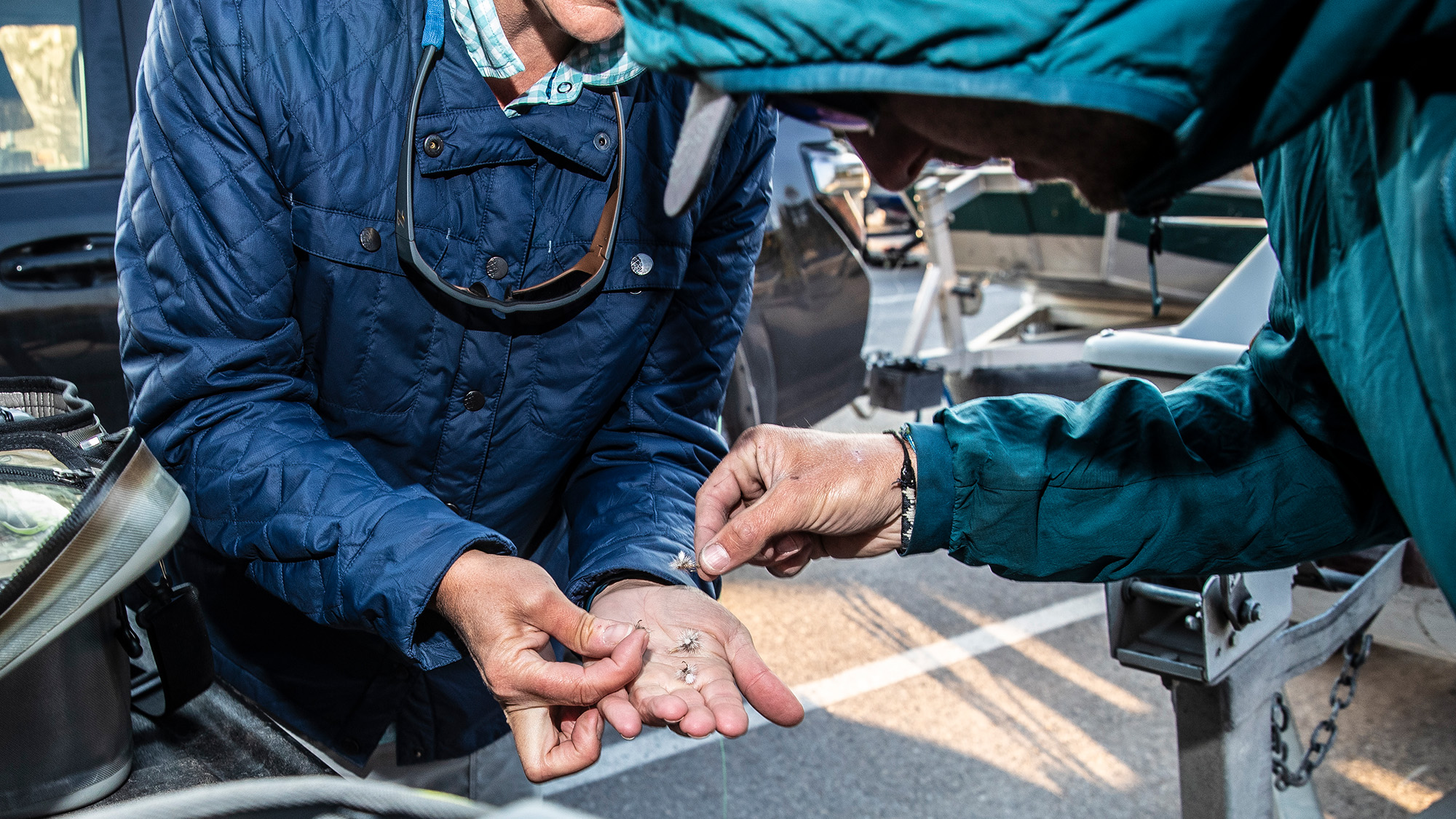
Photo by Neal Henderson
Because after you tie on a single fly, you’re committed for the day. Make the wrong pick and you’re in for a beatdown. Lose the fly and you’re done. Finito. Game over.
Praying on a Kidney Stone
Sept. 4, 3 p.m.
I’m sitting in the Jackson Library when two texts come in quick succession: “Will call you shortly … May have an opening.”
The two messages are from John Holland, the president of the Jackson Hole One Fly Foundation and one of the main coordinators of the event I’m here to cover … and hopefully, maybe, compete in. It starts in three days. I’m not exactly holding my breath; I’ve already had to give up a last-minute spot on a team due to my status as a former fly-fishing guide. But Holland says this is a different team, and his third text mentions something about health issues. I’m strangely excited by the dire news, and I hear from the team’s captain later that afternoon.
“So here’s the deal,” he says. “We have a guy who works at South Fork Lodge, but he has a kidney stone and might not be able to fish this weekend.”
“Bummer,” I say. It’s a lie but I sell it nicely. “I mean I am available if you need someone to…”
“Well, that’s the thing, we just don’t know yet. He was supposed to get it removed tomorrow and they had to reschedule … so he’s gonna have to pass it himself or … look, we’ll just keep you posted. Sorry I can’t give you a firm answer right now, but I should know something tomorrow. Call you then?”
Sept. 4, 6:15 p.m.
From the library, I drive over Teton Pass to Victor, Idaho, where my good buddy Joe Harris lives. A guide for WorldCast Anglers, Joe’s been harassing trout professionally here for the last 14 years. In addition to being one of my closest friends from college, he’s one of the fishiest humans I’ve ever met. At 6 foot 3 and 270 pounds, the North Carolina native is a mule on the oars, and like any good guide, he understands what makes fish tick. What sets Joe apart, though, is his prey drive, and his compulsive capacity for learning.
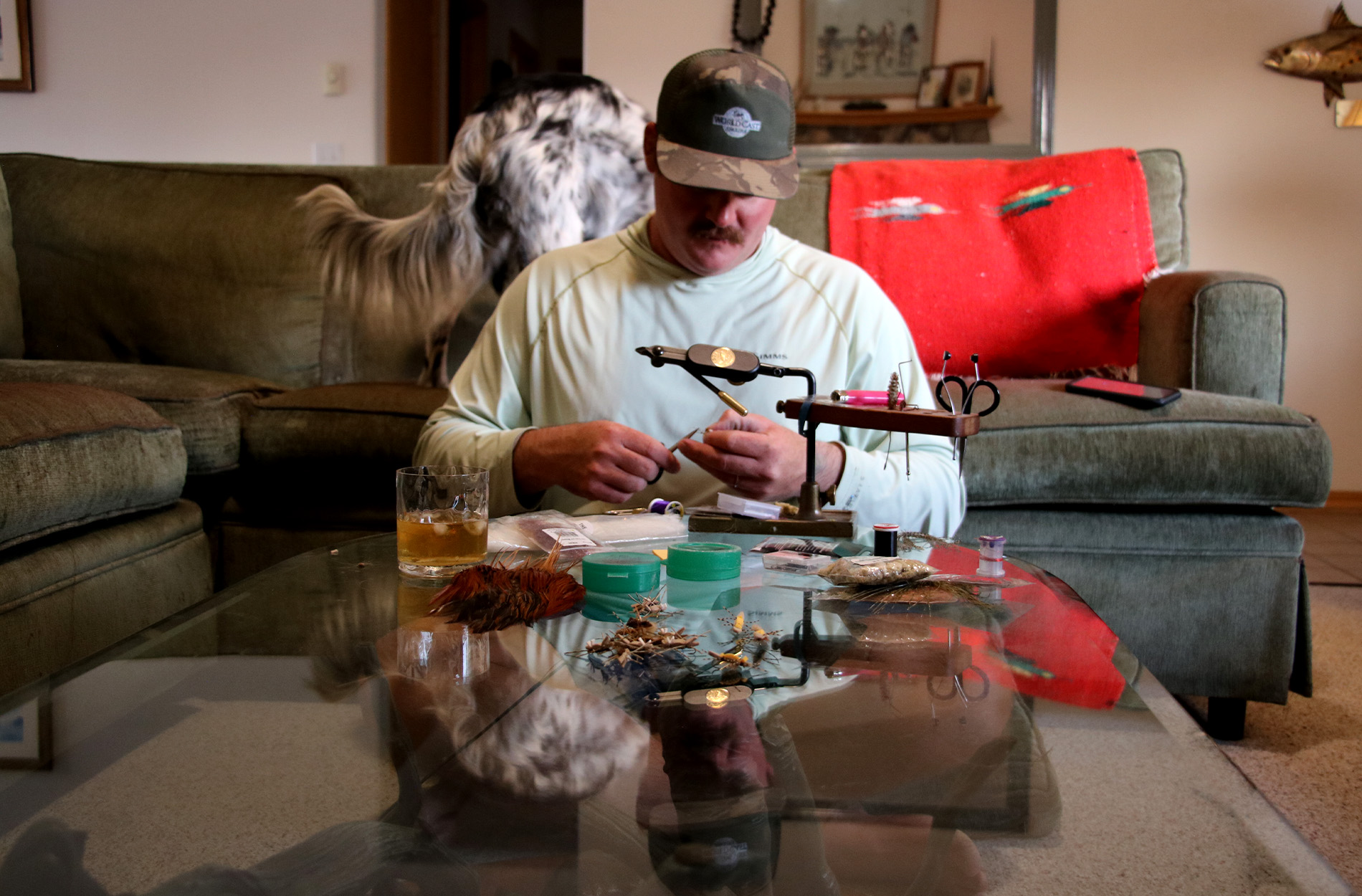
Photo by Dac Collins
So I’m not surprised when I walk into Joe’s living room to find him ranting about a dry fly. On the far side of the room sits Mike Janssen, one of Joe’s mentors and a fellow guide at WorldCast. He’s been involved with the One Fly for more than two decades, and he’s here to buy a handful of foam bugs from Joe. Because in a town like Victor, every fly fisherman is a junkie, every tier a supplier, and word gets around about who has the best dope.
“This is my buddy, Dac,” Joe says. “We went to Sewanee together. He’s here to write about the One Fly.”
“Ah, no way. That’s awesome, man!” Janssen says as we shake hands. “Does that mean you’re fishing it?”
“Well, I was hoping I might be able to, but I’m not really sure,” I say. I tell him about the kidney stone, and admit that although I’ve never met the guy, I’m really hoping he recovers … on Sunday night. “I don’t know whether to be stressed or excited at this point.”
“Sounds like you’re already on the roller coaster,” Janssen grins. “Welcome to the One Fly.”
Heartbreak on 4X
The guy with the kidney stone recovers in time, which means I’ll be spectating on Saturday instead of participating. My consolation, though, is a chance to fish a warm-up event with a select group of anglers before the real competition begins.
The bonus day commemorated a special year for the Jackson Hole One Fly Foundation. Because in April, the American Museum of Fly Fishing named the non-profit as the recipient of its 2024 Heritage Award. This is the highest honor given by the Museum, according to AMFF board president Fred Polhemus, who says the award honors the One Fly’s role in American fly-fishing culture (more on this in a minute) and because of the heaps of conservation dollars it generates annually. And in the spirit of tradition, the organizers added one more restriction to Friday’s warm-up event: In addition to being limited to a single fly, every angler would have to use a bamboo rod.
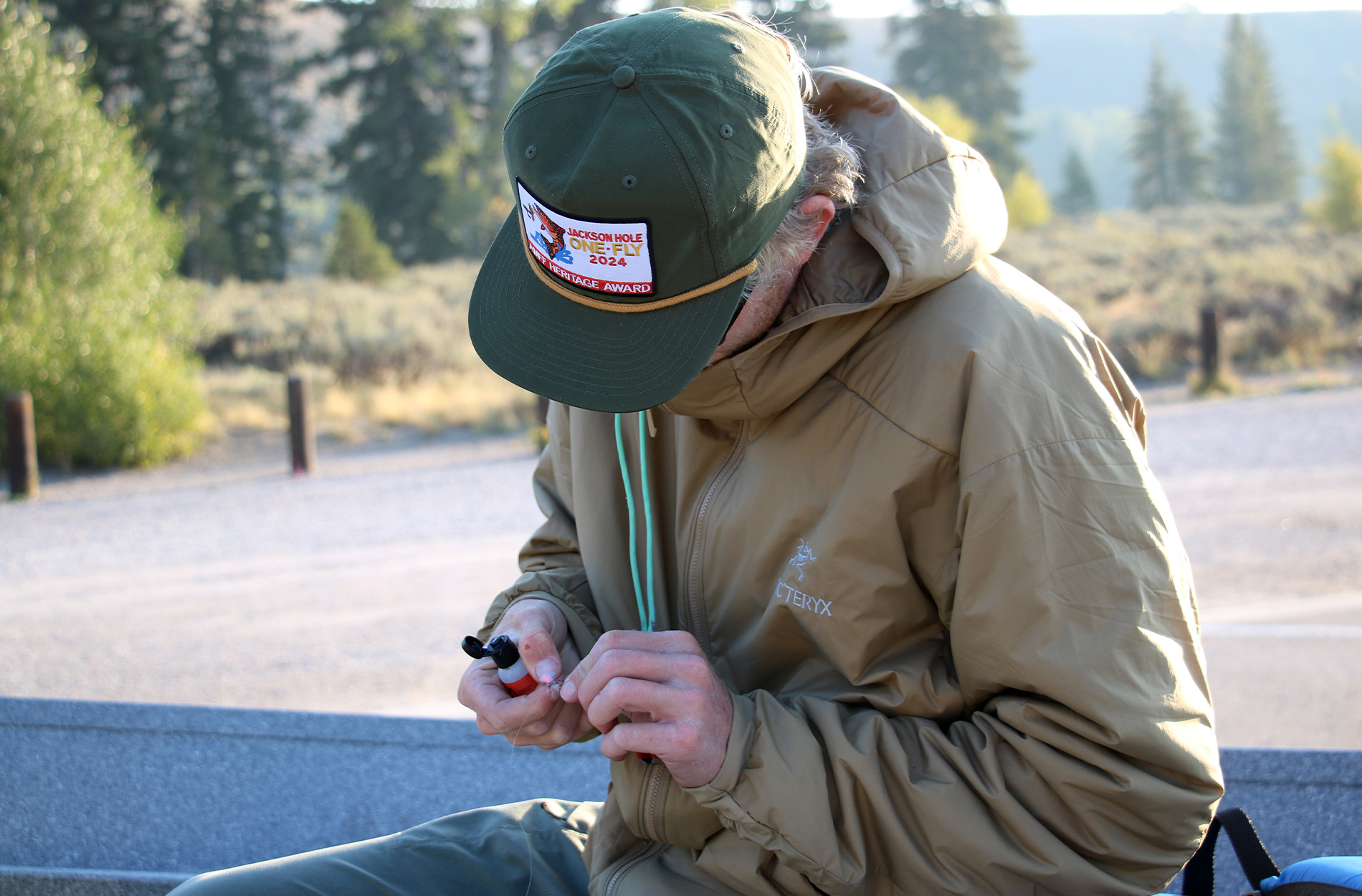
Photo by Dac Collins
The night before the derby took place, the AMFF’s curator handed me a 60-year-old Farlow’s Midge. The two-piece, split-cane rod was handmade in Scotland and designed by the legendary Lee Wulff, one of the sport’s greatest teachers and conservationists. I was both honored and nervous to use it; I’d never caught a fish on a bamboo rod before.
Sept. 6, 4 a.m.
I haven’t gotten a wink of sleep so I might as well get up and cast the Midge.
It’s pitch black out as I rig up in the yard by headlamp, but after a few false casts I kill the light. I don’t need to watch the line unfurl. I can feel the old rod loading in the bones of my hand.
Sept. 6, 9 a.m.
After meeting my boat mate, Jason Scott, and our guide, Luca Damian, in town, we drive into Grand Teton National Park to launch the boat. Scott and I are more than happy to fish small dry flies, and we settle on two different mayfly patterns that Damian suggests.
Using a bamboo rod to throw small dries is a delicate style of fishing that needs a sensitive touch. And even though I ask if we should fish with 2- or 3X tippet (the equivalent of 10.5- and 8.5-pound-test line) “just in case,” I find it hard to disagree with Damian, who assures us that fishing 4X (which tests at about 6 pounds) is the answer. We’ll get more looks, he says.
I don’t think he was wrong. Scott and I have raised a few small cutties, and we’re both on the board by mid-morning. A chill hangs over the river, which seems to slow the bite over the next couple hours, and I could definitely use some more caffeine. But my casting stroke feels smooth and my confidence in the size-16 dry fly is growing.
Sept 6, 12:30 p.m.
We’re drifting through a deep run that drops off a gravel bar when a fish charges up at Scott’s fly and misses. We hoot at the bluebird sky as Damian catches an eddy, and when he drops the anchor I give Scott a look that says, “All yours, dude.”
A lifelong fisherman who just got back from steelheading in B.C., it’s a joy to watch him work. Scott wades out into the run and casts upstream, and after a few short drifts he comes tight to a cutthroat. We can tell it isn’t the fish when it lands in Damain’s net, but it’s still a solid 12-incher — a scoreable trout.
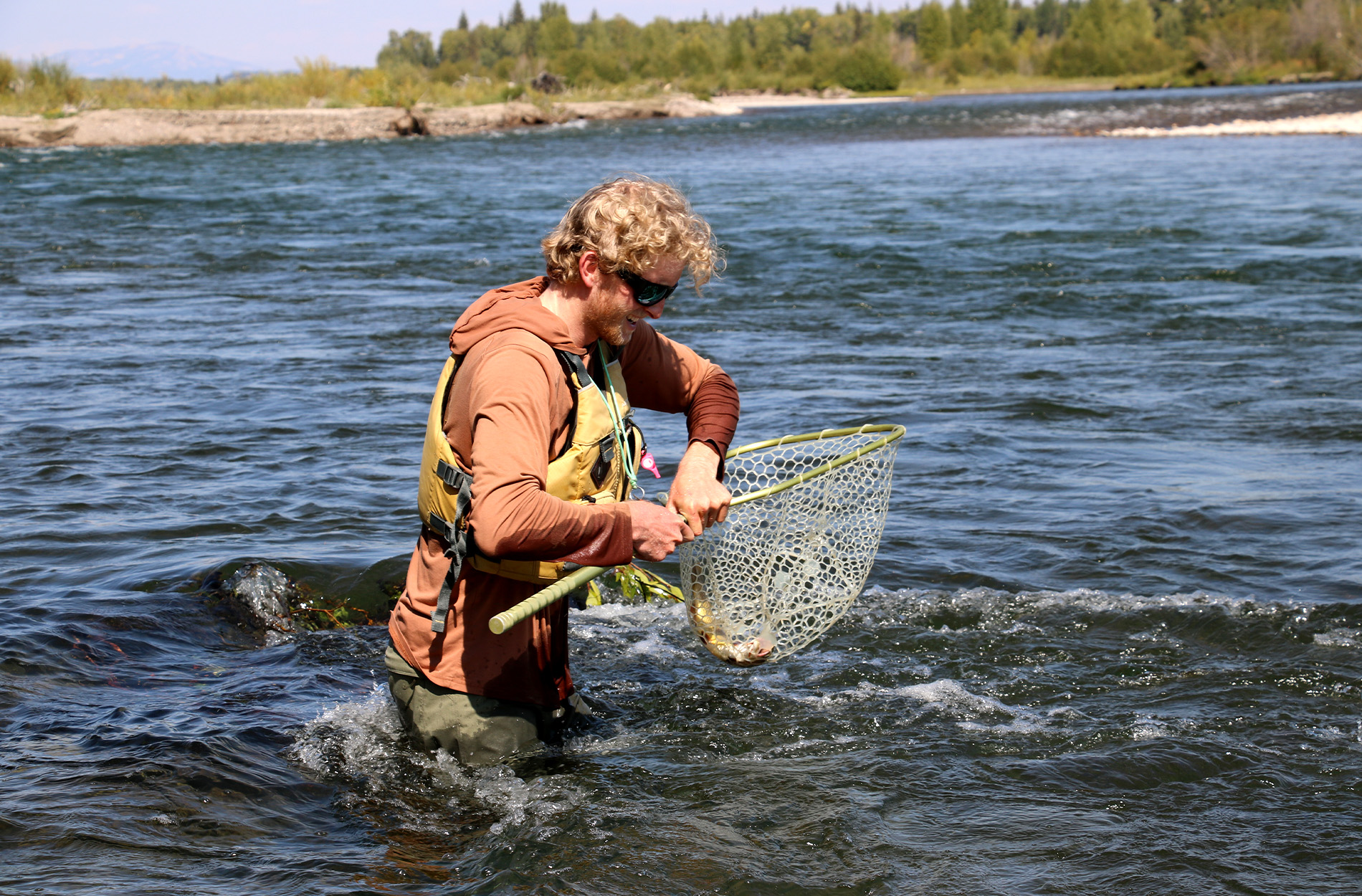
Photo by Dac Collins
Now it’s my turn to see if any players are home. It takes me a bit longer to find the right line, a slow seam that’s just far enough away to make mending impossible. A fish eats my dry and I raise the rod and whiff. Too early, I guess, or maybe the fish just missed it.
And at this point, a seasoned One Fly veteran would have taken a moment to patiently inspect the fly and the leader for any nicks or frays. Cutthroat have rough mouths, and since 4X is on the lighter side, it’s always wise, if you want to keep your fly, to triple-check your leader and retie your knots.
But no. Not this eager bastard. Feeling slighted by a pea-brained fish, I pull my cap down over my forehead and take one step back before casting again. It’s the same exact drift and the trout eats in the same spot, rising with a splash as it sucks down the fly. I lift up on the Midge. The hookset feels pure and oh-so-sweet, and then the tippet breaks and my fly departs, still fastened to the trout’s upper lip. The bamboo rod turns lifeless in my hand as I stand knee-deep in cold water and shame.
Sept. 6, 3:30 p.m.
I don’t think these guys can tell I’ve been sulking for DQing myself so early in the day — one of the few benefits of being stuck in the back.
We explored a back channel about an hour ago, and I cheered Scott on as he sight-casted to an 18-incher in ankle-deep water. But now that the bite has really picked up, I’m getting tired of watching him rail on fish. I can’t believe I didn’t bring any beer.
With just minutes on the clock I catch two small trout on a hopper. They don’t count toward my score, but that’s alright. I release the second fish and look toward the Tetons, which feel impossibly close to the riverbank. There are worse places to be humbled.
Building the Money Machine
The first Jackson Hole One Fly competition was held in 1986. It was conceived and developed by two local fishing guides, Jack Dennis and Paul Bruun. The founding editor of the Jackson Hole Daily and a member of the Fly-Fishing Hall of Fame, Bruun calls his friend Dennis “the Father of the One Fly.”
Bruun says that Dennis, a pioneering fly tyer and an early ambassador of the sport, was already designing quasi-indestructible flies that could survive a full day’s thrashing. He’d also heard about the famous One Shot Antelope Hunt in Lander, where teams of hunters are given just one bullet for the day and they race to bring back the biggest buck. It seemed natural to translate this to the trout stream, so Dennis gathered a group of guides, business associates, and longtime clients.
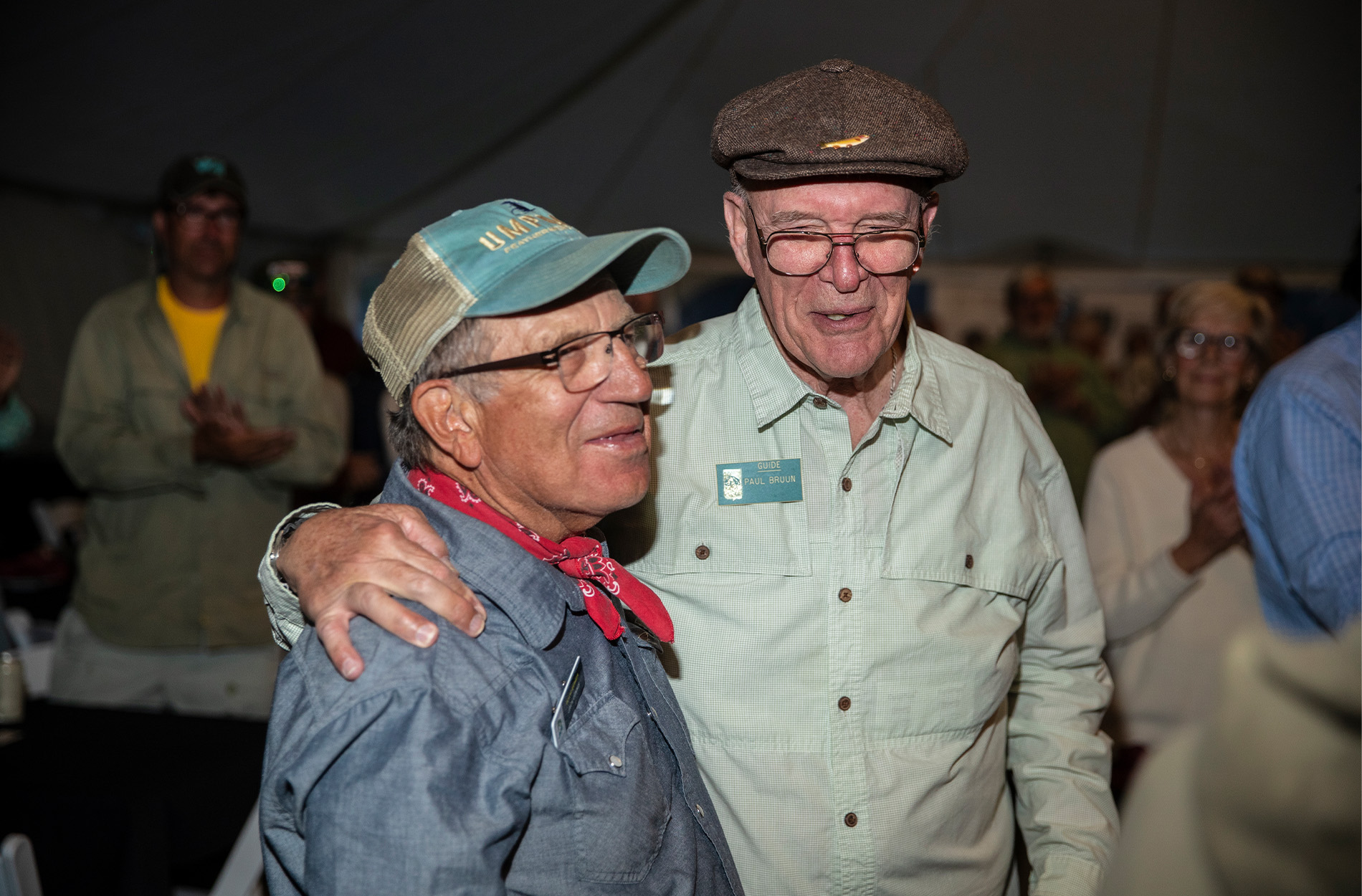
Photo by Neal Henderson
“It started out as just a fun thing to do, and we all got into it. You knew everybody back then, and we were still fishing Royal Wulffs and Trudes,” Bruun says about the first few years he guided in the competition. “I remember one year I had this guy, a filmmaker. He hooked a 22-and-a-half-inch fish at the Sheep Gulch boat ramp, and we landed it in front of everyone … but that was before the guides got any prizes. I peaked too soon.”
The event blossomed. And as the small Wyoming town transformed during the 90s into a tourist hub (and a second home enclave for top earners and Hollywood glitterati) there was no shortage of people signing up to fish the tourney. To name a handful of fly-fishing icons and celebrities who’ve competed over the years: Curt Gowdy, Joan Wulff, Tom Brokaw, Mike Lawson, Tom Skerritt, George Anderson, Stu Apte, and Joe Humphries.
Read Next: Amelia Earhart on Flying and Fly Fishing, from the Archives
But Bruun says the One Fly didn’t start out as a charity event. And it might have been a one-off deal if not for a tragedy that occurred during the first hour of the first-ever competition. A guide, Peter Crosby, was wading with clients when his raft got away from him. Crosby, who had a wife and two kids at home, went chasing after his boat in his waders and drowned.
“That was nearly the end of the One Fly before it even got started,” says Bruun. But by the time the organizers gathered that night, their grief had catalyzed into something else. “We said, ‘We can’t let this go.’ So, for quite a while, all the proceeds went to his family.”
This gave the 1987 One Fly, and each one that followed, a cause to rally around, and its organizers carried that momentum into the conservation realm.
“It just grew from there,” Bruun says, and he adds that several copycat events have cropped up in different fisheries over the years. “It was the right concept at the right time.”

Photo by Neal Henderson
That growth has only accelerated, with a line of hopeful anglers waiting to cough up the dough to form a team. The charity event, and particularly the auction that kicks it off, consistently brings in six figures — thanks in no small part to the energy of Holland, the JHOFF president. This year they raised nearly half a million dollars to benefit rivers and wild fish, and to date, the foundation has leveraged matching grants to fund roughly $25 million in conservation projects throughout the West.
Now, when that kind of money is in play, people talk. And there are rumblings of concern about the One Fly’s future. Some worry that the sheer amount of dollars fueling the fun could turn the event into something more akin to a polo match that is reserved for the wealthiest stable owners.
But even in light of these undercurrents, Bruun says the essence of the One Fly remains the same. Camaraderie, competition, and the love of wild trout are still the driving forces. And who cares if some people want to throw some money around if it all ends up in the river?
By the Skin of My Teeth
Sept. 7, 9 p.m.
Our dinner is winding down at a tavern in Jackson, and I’m sitting with Holland and his teammates. Between us are about four empty bottles of damn good red wine. I’m warm in the cheeks and deep in conversation when Fred Polhemus from the Museum walks up to our table. He’s hunched over and a little sunburned.
“John,” Polhemus says, “I need you to find someone to take my spot tomorrow. I’ve got a bad hip, I’m in serious pain, and I just can’t get back in a drift boat.”
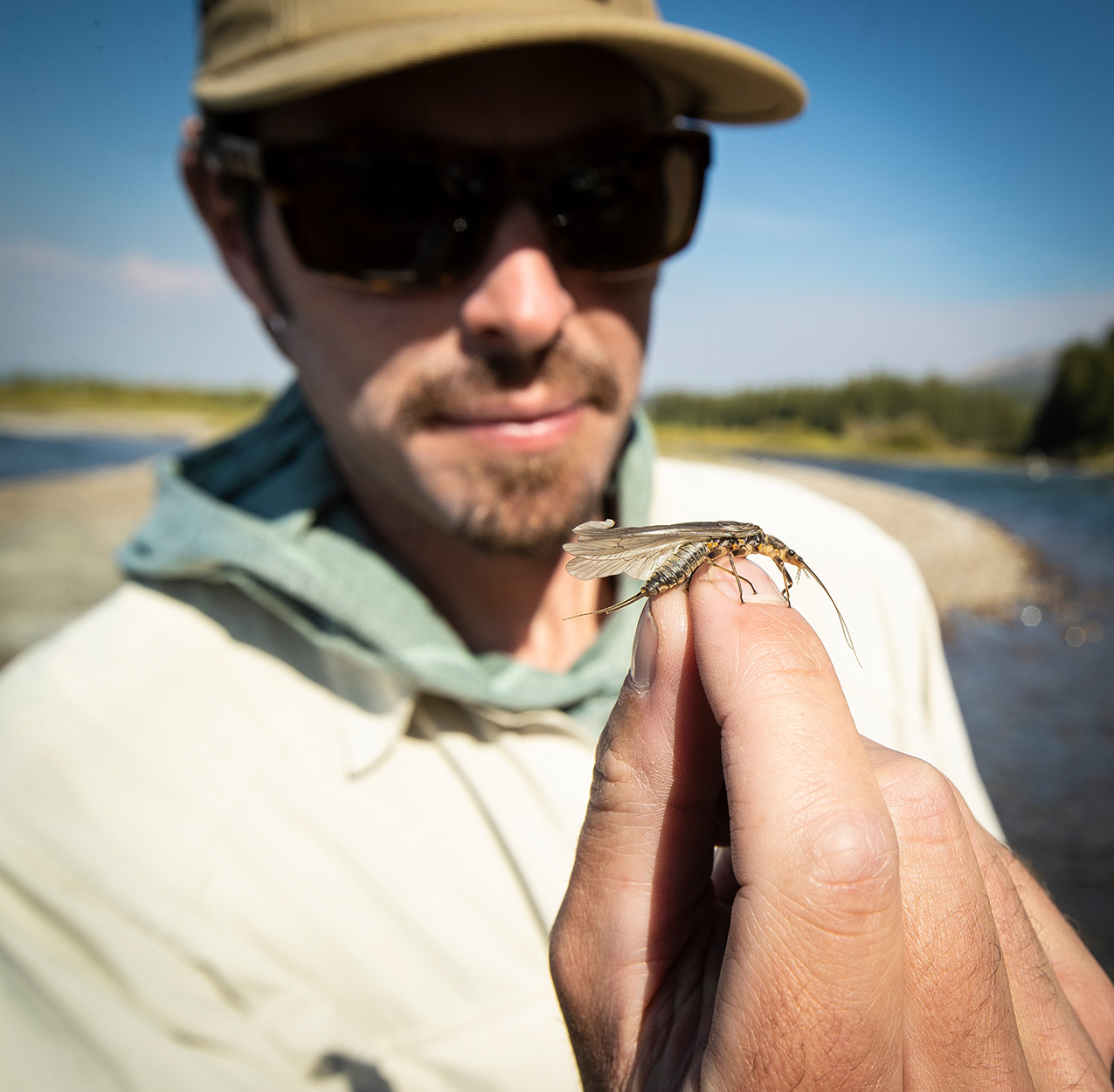
Photo by Neal Henderson
Holland assures him he’ll figure something out. Then he looks over at me.
“Well. Time to lace ‘em up. Looks like you’re fishing the South Fork.”
Sept. 8, 7 a.m.
Stevie Ray Vaughan is blaring as I pull into the American Legion in Swan Valley. I see my buddy Joe right away. I let him know last night that I was pulled off the bench, and he flags me over to his truck.
“Here you go, dude,” he says and drops an olive streamer in my hand. “It’s heeeaavy. Fish it on 10 feet of 0X and jig the shit out of it. They’re not where they should be along the cutbanks. Most of our fish yesterday came off shallow gravel.”
Read Next: How to Be a Fish Bum: These 6 Fishermen Are Living the Dream
I look down at the fly, maybe the hundredth I’ve bummed from Joe over the years. I’ve been catching trout on his streamer patterns since we were teenagers in Tennessee, but I don’t need to remind him. And I certainly don’t need to bring up scores. He’s leading the pack of 82 guides and well on his way to winning the thing.
“Get ‘em, Joe.”
Sept. 8, 7:55 a.m.
I’m at the ramp talking strategy with Jim Fisher, who’s in his 22nd year fishing the One Fly, and our guide Brenda Swinney, who’s been working on the South Fork for longer than that. I know it’s ultimately my decision to choose a fly, but out of respect for a veteran guide, I don’t want to tell Swinney how to run her own program. I also know that she knows Joe, and I feel like I can drop a hint.
“I mean, I do like to fish streamers. And I ran into Joe earlier, he gave me a fly,” I say. “But if you have a favorite pattern …”
“No,” Swinney says with a smile. “You should fish Joe’s streamer.”
Sept. 8, 10 a.m.
Fisher and I have hit the two-hour mark and we’ve yet to catch a fish. It’s windier than an Oklahoma trailer park and there isn’t a cloud in the sky. Joe’s fly is doing its job, though. I hooked and lost a solid fish in the first hour, and I’ve had a couple short strikes since then.
Fisher, who’s dead drifting a stonefly nymph from the bow, doesn’t seem too worried. A retired judge from Michigan with a sharp sense of humor, he’s happy enough telling stories. His team has also won the amateur division two out of the last four years, and I can recognize a good angler when I see one. I figure if he’s not catching fish, maybe it’s just a tough morning.
Sept. 8, noon
I still haven’t caught a thing, and the fishing has, somehow, gotten suckier. So I’m casting like a maniac. I’m hammering every piece of water I can reach. I’m changing my cadence and jigging and crawling and twitching the fly, and nothing seems to be working. It doesn’t help that I can’t shake the one shot I had this morning. How did I not stick that fish?
Fisher’s still scoreless, too, his two whitefish worth zilch in a trout-fishing competition. And the fact that he’s getting skunked on a rubberlegs stonefly nymph, which should be automatic, is troubling all three of us. The boat’s getting quieter by the minute. Fisher tries to lighten the mood.
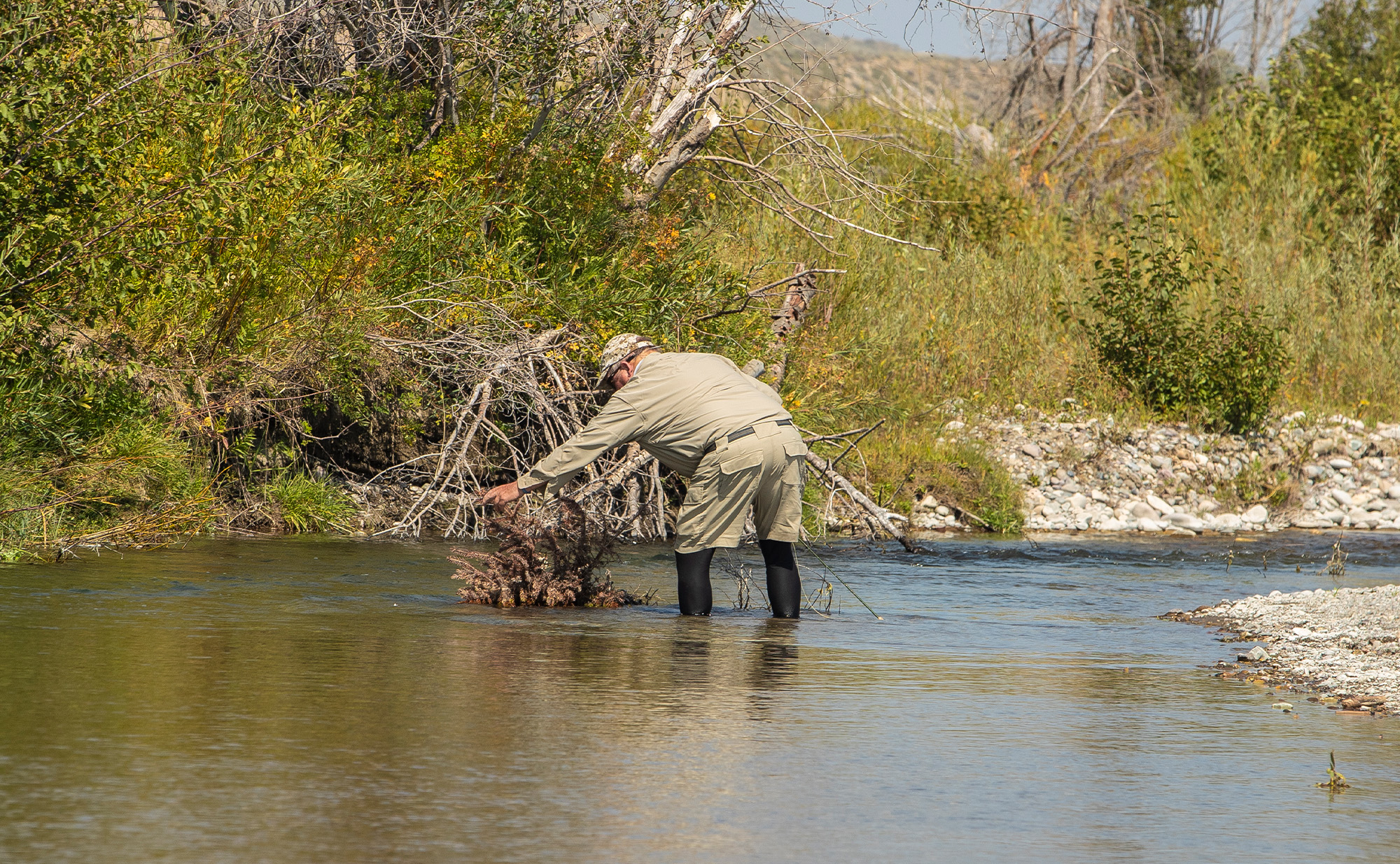
Photo by Neal Henderson
“When do you think the fish will start biting, Brenda”
“Oh. About 12:15,” she replies.
Sept. 8, 12:30 p.m.
I’m speaking less and less. And I’m wondering if I have enough cigarettes to make it through the afternoon when Swinney says something like, “Well, we might as well take a long lunch since the fishing is so slow.” I tell myself not to be a chomper, one of those guys who just wants to catch ‘em, catch ‘em, catch ‘em. It’s okay, man. Relax.
But it’s not okay. We have a brutally long lunch.
Sept. 8, 1:30 p.m.
“When do you think the fish will start biting, Brenda”
“1:45,” she says.
It’s still sort of funny, but I’m no longer laughing. My shoulder is sore, my brain feels mushy, and I can feel myself cooking in the sun. Water and sunscreen are nowhere near top of mind. Because there could be a fish right there.
There isn’t. And I’m still having daymares about the trout I didn’t land this morning.
Sept. 8, 2 p.m.
Fisher and I are both scoreless with two hours left, and there’s a real possibility I won’t catch a single fish today. I’ve gone from panicking to having a full-blown personality crisis.
Normally, getting skunked wouldn’t bother me. It’s happened before and it’ll happen again. But this is different. I’m competing. And the fact that I, an outdoor writer at an esteemed publication, might fail to catch a trout on one of the West’s most productive tailwaters is beyond embarrassing. I am a fraud.
The only comforting thought is that I can sell all my fly rods and disappear, maybe convince the wife to move to Hawaii. I could always take up surfing.
Sept. 8, 2:30 p.m.
I’m still a fishless, anxious wreck. Swinney slides over to some soft water near a shelf and drops anchor at the top of a long run. It’s a perfect time for a smoke break, and as I dig one out of my breast pocket, I notice a mass of clouds building overhead.
The weather turns in minutes, the sun awash in gray. Then the thunder rolls as the river gods flip a holy switch in the sky.
I’m halfway through my cigarette when Fisher lands a trout. I suck the Marlboro down like it’s my last minute on Earth and start fishing again. It doesn’t take long, but I almost don’t believe it when my line finally tightens. I skip the trout into the net, and it’s a dink but it’s a fish. A fucking glorious fish.

Photo by Dac Collins
As we’re coming around the next bend, Fisher’s bobber drops and we can tell right away it’s a toad. He keeps the fish out of the wood and it makes a solid run in the current. Swinney rows down after it and finally nets the 19-inch cutbow. She’s relieved, Fisher is stoked, and I finally feel like myself again.
Sept. 8, 3:55 p.m.
Our ninth-inning luck has continued. Fisher is on fire up front, and every inside bend holds a trout that wants to crush Joe’s streamer. I’ve landed six fish and hooked nine in the final hour. I’ve moved a couple more, including a tank of a brown that turned away at the last second.
It would’ve been nice to catch her and add to my mediocre one-day total, which puts me in the bottom third of the final rankings. But I’ll find it easy enough to shrug off my own score at tonight’s banquet, when Joe is named top guide with the most points netted over two days.
Besides, I still have my fly. Along with the knowledge that somewhere, someday, it will get eaten again.
The post Diaries from The One Fly, the Strangest Fishing Contest in America appeared first on Outdoor Life.
Source: https://www.outdoorlife.com/fishing/one-fly-competition/





